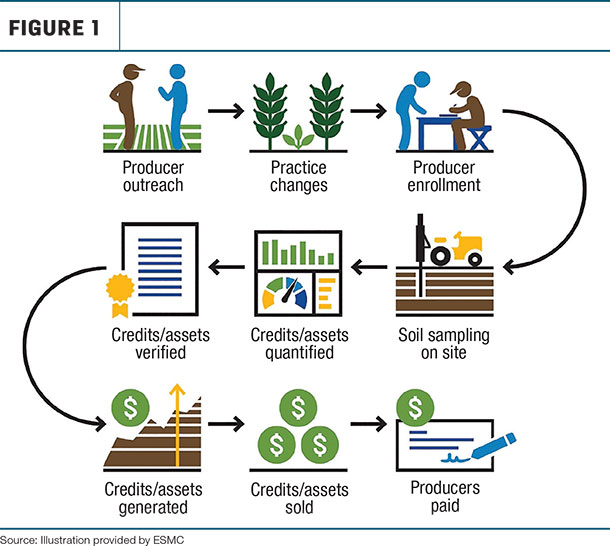Carbon market programs can offer agricultural producers strong incentives to implement practice changes that reduce greenhouse gas emissions and improve soil health. Some programs, like Ecosystem Services Market Consortium (ESMC), also provide additional ecosystem services credit opportunities for water quality, water quantity and biodiversity improvements.
In essence, these programs work by paying agricultural producers for verified emission reductions and environmental improvements. In addition to the payments from these programs, practice changes can have direct benefits for producers, like improving overall soil health, soil fertility and productivity. Improved soil health makes production systems more resilient and less impacted by extreme weather. In addition, better soil water-holding capacity resulting from improved soil structure can reduce nutrient losses and lower irrigation requirements.
With many programs operating in the carbon marketplace, producers should understand key details about how programs differ and what items to look for. This article highlights some questions producers should ask before enrolling in any specific carbon or ecosystem services market program.
Production system
For forage producers, the first important question to ask is whether a program covers forage crops. Some carbon market programs may focus on only corn and soy, while others may include a variety of crops and cropping systems that would include all aspects of forage production.
Practice change requirements
An important component of any carbon and/or ecosystem services market program is: Producers need to make practice changes after enrollment so programs can compensate them for the environmental benefits from those changes. For most markets, producers have the ability to decide which practices and systems they implement on their land so they can continue to manage their operations in ways that work best for them. Key practice-specific questions include:
1. Who decides which practices producers must implement for program enrollment?
2. Does the program contain a menu of practice change options? Depending on the program, practice change options may include cover cropping, tillage reduction, nutrient management, cropland grazing, conservation cropping rotation, edge-of-field conversion of cropland to grassland or others.
3. Do producers need to enroll all of their acreage?
Producer payments
Carbon and ecosystem services market programs can differ significantly in how much producers are paid for their credits, if payments are offered by acre or by outcome, and if they are carbon-only or include other ecosystem services such as water quality, water quantity or biodiversity. Payment-specific questions for producers should include:
1. Are producers paid to make practice changes (usually paid by the acre) or for the verified outcomes of practice changes (usually through a carbon or water quality credit)?
2. How much will producers be paid?
3. How long does it take producers to get paid once they start making practice changes?
4. Does the program pay producers only for carbon, or are there other ecosystem services benefits included (such as water quality and biodiversity)? If the program covers more than carbon, can producers stack credits on the same acre of land (for example, carbon and water quality)?
Participation costs
As payments to producers differ by program, so do possible overhead costs. It is important to understand whether the producer needs to purchase specific agricultural inputs or technical support to participate in a market program before signing up. Producers should inquire about the following:
- How much does the program offer per acre or per credit?
- Is there a fee to participate in the market program?
- Does the producer need to purchase additional inputs or services to qualify?
- Who pays for the sampling expenses, monitoring and verification costs, etc.?
Data protection and ownership
Producers understand their data is one of their most valuable commodities. Participating in a carbon or ecosystem services market necessarily requires some land as well as practice data to be shared with the program. Producers need to understand:
1. Who owns producer data in the market program?
2. Who has access to producer data?
3. What type of producer data privacy protections are in place?
Risk
In deciding whether to participate in any market program, producers must look at any and all risks to their operations. Questions about who takes on the risks in these programs can include:
- Who assumes the risk with the practice changes?
- Is there a minimum payment guarantee for the first year?
- How do producers know there will be a buyer for their credits?
- What happens if land ownership changes during the course of the contract?
What is laid out here are a number of questions and considerations for market program participation. As these markets develop further, producers likely will have additional options for enrollment and participation.
Where to start
ESMC is a nonprofit, member-based organization launching a national scale ecosystem services market program for agriculture to recognize and reward producers for their environmental services to society. The current program development starts with producer outreach, then practice change, enrollment, soil sampling, credit quantification, credit verification, credit generation, then credit sale and producer payments (Figure 1).

ESMC is enrolling producers for the 2023 growing season. Many production regions are eligible for enrollment, and producers growing corn, soy, wheat, alfalfa, sorghum, oats, switchgrass and other crops qualify for participation. As highlighted in the article, producers must enroll in ESMC’s program prior to making a practice change.










